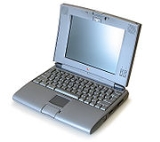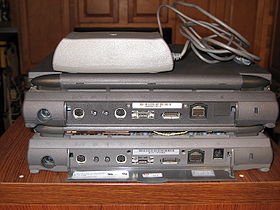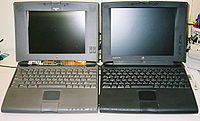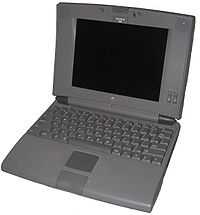
PowerBook 500 series
Encyclopedia
 |
|
| PowerBook 500 series | |
|---|---|
| Manufacturer | Apple Computer Apple Computer Apple Inc. is an American multinational corporation that designs and markets consumer electronics, computer software, and personal computers. The company's best-known hardware products include the Macintosh line of computers, the iPod, the iPhone and the iPad... |
| Type | Portable computer Portable computer A portable computer is a computer that is designed to be moved from one place to another and includes a display and keyboard. Portable computers, by their nature, are generally microcomputers. Portable computers, because of their size, are also commonly known as 'Lunchbox' or 'Luggable' computers... |
| Pointing device | Built-in Trackpad |
| Introduced | 16 May 1994 |

PowerBook
The PowerBook was a line of Macintosh laptop computers that was designed, manufactured and sold by Apple Computer, Inc. from 1991 to 2006. During its lifetime, the PowerBook went through several major revisions and redesigns, often being the first to incorporate features that would later become...
portable computer
Portable computer
A portable computer is a computer that is designed to be moved from one place to another and includes a display and keyboard. Portable computers, by their nature, are generally microcomputers. Portable computers, because of their size, are also commonly known as 'Lunchbox' or 'Luggable' computers...
s first introduced by Apple Computer
Apple Computer
Apple Inc. is an American multinational corporation that designs and markets consumer electronics, computer software, and personal computers. The company's best-known hardware products include the Macintosh line of computers, the iPod, the iPhone and the iPad...
with the 540c model on 16 May 1994. The 500 series was the first laptop computer to use a trackpad instead of a trackball
Trackball
A trackball is a pointing device consisting of a ball held by a socket containing sensors to detect a rotation of the ball about two axes—like an upside-down mouse with an exposed protruding ball. The user rolls the ball with the thumb, fingers, or the palm of the hand to move a cursor...
as a built-in pointing device and the first to have Ethernet
Ethernet
Ethernet is a family of computer networking technologies for local area networks commercially introduced in 1980. Standardized in IEEE 802.3, Ethernet has largely replaced competing wired LAN technologies....
networking built-in.
It was the first PowerBook series to use a Motorola 68LC040 CPU
Motorola 68000
The Motorola 68000 is a 16/32-bit CISC microprocessor core designed and marketed by Freescale Semiconductor...
(simultaneous with Duo 280
PowerBook Duo
The PowerBook Duo was a line of small subnotebooks manufactured and sold by Apple Computer from 1992 until 1997 as a more compact companion to the PowerBook line. Improving upon the PowerBook 100's portability , the Duo came in seven different models...
) and be upgradeable to the PowerPC
PowerPC
PowerPC is a RISC architecture created by the 1991 Apple–IBM–Motorola alliance, known as AIM...
architecture via a swap out CPU daughter card (with the PowerPC and 68040 upgrades for sale), use 9.5" Dual Scan passive color/B&W displays, 16bit stereo sound with stereo speakers, have an expansion bay, PC Card capability, two battery bays (and a ten minute sleep/clock battery), full size keyboard with F1-F12 function keys, be able to sleep while connected to an external monitor and have a battery contact cover included on the actual batteries. It included a single serial port which could be to connect to a serial printer or a network via Apple's LocalTalk
LocalTalk
LocalTalk is a particular implementation of the physical layer of the AppleTalk networking system from Apple Computer. LocalTalk specifies a system of shielded twisted pair cabling, plugged into self-terminating transceivers, running at a rate of 230.4 kbit/s...
. In another first, it also included an AAUI
Apple Attachment Unit Interface
Apple Attachment Unit Interface is a mechanical re-design by Apple of the standard Attachment Unit Interface used to connect Ethernet transceivers to computer equipment...
port for connecting to non-LocalTalk (usually Ethernet
Ethernet
Ethernet is a family of computer networking technologies for local area networks commercially introduced in 1980. Standardized in IEEE 802.3, Ethernet has largely replaced competing wired LAN technologies....
) networks.
The 500 series was discontinued completely with the introduction of the ill-fated PowerBook 5300
PowerBook 5300
The PowerBook 5300 series was the first generation of PowerBook laptops manufactured by Apple Computer to use the PowerPC processor. Released in August 1995, these PowerBooks were notable for being the first to feature hot-swappable expansion modules for a variety of different units such as ZIP...
. The PowerBook 190
PowerBook 190
The PowerBook 190 and its companion PowerBook 190cs are laptop computers manufactured by Apple Computer as part of their PowerBook brand, introduced to the market in August 1995. The two models differ only in their screen: The 190 had a 9.5" greyscale display, while the 190cs featured a 10.4" color...
was the de facto successor to the 500 and continued the only 68LC040 processor offering as the low-end of the PPC
PowerPC
PowerPC is a RISC architecture created by the 1991 Apple–IBM–Motorola alliance, known as AIM...
-based PowerBook family.
The 540c is rated #2 of the all time best PowerBook models made according to Insanely Great Macintosh (survey taken Nov, 2000).
History
It was introduced on 16 May 1994 with the expensive active matrix LCD PowerBook 540c and 540, with the passive matrix 520c and 520 soon after. One of its marketing highlights was the promise of a PowerPC upgrade to its CPU and PC Card (PCMCIA) expansion. The introduction of this model came at the time of Apple's change over to the new PowerPC Chip from the 68k line of CPU's, and Apples advertising and promise of the PowerPC was the cause of headaches to the company. The resulting strong demand for its ground breaking design and wrong market prediction of waiting for the fully PowerPC PowerBook resulted in shortages early on.In due course the 540 was dropped from the line, 8 mb of additional memory and the modem was offered installed from the factory, hard drive capacity was increased (from 160 and 240 to 320 and 500 mb), and the installed system upped from System 7.1.1 to 7.5. The PC Card Cage also started to sell on the market.
In 1995 Apple gave permission for Apple Japan to introduce an updated version, called the 550c, with a bigger display (10.4"), CPU with FPU (68040), bigger hard drive, and Japanese keyboard. It was only sold in Japan, and never received FCC certification.
With delays in the new PowerPC book (5300), demand for the PPC upgrade mounted, and Newer Technology began to market the upgrade before Apple did, although they had produced the upgrade modules for Apple first. What's more, they offered 117 MHz versions over Apples 100 (actually, 99) MHz offering. Soon there after Newer introduced a 167 MHz model that outperformed the fastest PowerBook 5300
PowerBook 5300
The PowerBook 5300 series was the first generation of PowerBook laptops manufactured by Apple Computer to use the PowerPC processor. Released in August 1995, these PowerBooks were notable for being the first to feature hot-swappable expansion modules for a variety of different units such as ZIP...
, the $6800 5300ce, at a time when problems with that line became a real issue to Apple.
About the time Apple introduced the PowerBook 1400
PowerBook 1400
The PowerBook 1400 was a notebook computer designed and sold by Apple Computer from 1996 to 1998 as part of their PowerBook series of Macintosh computers. Introduced in November 1996 at a starting price of $2499, it was the first new PowerBook since the controversial PowerBook 5300...
, Newer introduced a 183 MHz upgrade with 128 Kb of L2 Cache that kept it ahead of the power curve performance wise. Newer Technologies stated they could not produce more of the 183 MHz upgrades because the supply of connectors was exhausted.
Impact on the Industry
This laptop was the first in the industry to include:- Track pad (instead of track balls, pointer (IBM), or mouse), offered on most laptops today
- 16bit stereo sound @ 44.1 kHz (Typical was 8bit mono @ 22 kHz)
- Stereo speakers (located in upper corners of screen)
- Ethernet via AAUI (A transceiver was used to connect to either UTP or Coaxial type wiring)
- Non specialized internal expansion bay for connecting many types of devices (PDSProcessor Direct SlotProcessor Direct Slot or PDS introduced by Apple Computer, in several of their Macintosh models, provided a limited measure of hardware expandibility, without going to the expense of providing full-fledged bus expansion slots.Typically, a machine would feature multiple bus expansions slots, if any...
connector in left battery bay). - "Intelligent" NiMH batteries (that is, had on-board circuitry to monitor health of battery)
- CPU on a daughter card, unique for a notebook.
And among Apple's PowerBook line the first to have:
- 68LC040 (with Duo 280), or 68040 (in Japanese model) CPU standard.
- PowerPC 603e CPU as an upgrade
- 9.5" displays
- 10.4" display (550c in Japan)
- Dual Scan passive color and B+W screens
- CPU on daughtercard (first in any Mac) (PowerPC and 68040 upgrades)
- Expansion bay (PDSProcessor Direct SlotProcessor Direct Slot or PDS introduced by Apple Computer, in several of their Macintosh models, provided a limited measure of hardware expandibility, without going to the expense of providing full-fledged bus expansion slots.Typically, a machine would feature multiple bus expansions slots, if any...
connector in left battery bay) - PC Card capability (PCMCIA) via module
- 2 battery bays (and a 10 minute sleep/clock battery)
- Full size keyboard with function keys (F1-F12)
- Sleep while connected to external monitor
- Battery contact cover included on the batteries
Variations across the range
Although the 500 "Blackbird" prototypes were black, only one of the five production models was completely black; that was the 550c, sold only in Japan. The 550c differed from the four two-tone grey models in a few other key respects as well, including a larger active-matrix color screen, a combined Roman/Kanji keyboard, and a full 68040Motorola 68040
The Motorola 68040 is a microprocessor from Motorola, released in 1990. It is the successor to the 68030 and is followed by the 68060. There was no 68050. In keeping with general Motorola naming, the 68040 is often referred to as simply the '040 ....
processor. The other models were all charcoal grey with darker grey trim, came with a variety of displays (active/passive matrix; color/greyscale), and used the 68LC040 processor (a low-cost variant without a math co-processor). The full-sized keyboard with 12 function key
Function key
A function key is a key on a computer or terminal keyboard which can be programmed so as to cause an operating system command interpreter or application program to perform certain actions...
s, and used a 640x480 resolution display was consistent across the family.
Optional Internal Modem
The modem was developed with Global VillageGlobal Village (telecommunications)
Global Village was a leading manufacturer of easy-to-use fax modems and other telecommunications products for the Apple Macintosh platform. It was one of the few manufacturers to support the Mac's RS422 serial ports without requiring an adaptor...
, and is a unique 2 part design. The transceiver with the modem connector is installed in the back, and the modem itself is located next to the CPU daughter card. It was a V.32 Terbo, and had a top rate of 19.2 kbit/s, but only with other V.32 Terbo modems as there was no official standard. Otherwise it would drop down to 14.4 kbit/s.
Due to a bug with the new combined printer/modem port, the driver had to be upgraded to 2.5.5, and the Chooser was replaced in the GV install.
Expansion bay
The 500 series of PowerBooks included the ability to use two batteries at the same time, allowing for 4 hours of battery life from two installed charged batteries. However the left batter also had an internal PDS slot that allowed for custom modules to be installed. Despite protypes being made, only 2 devices reached the market.PCMCIA "card cage"
One is the PCMCIA module. There were three versions; RevA, RevB and RevC. The RevC is the most useful as it can take 16bit WiFi cards, allowing the possibility to get a Powerbook 5xx connected online or in the home network using a technology that was developed after the Powerbook 5xx's were discontinued by Apple. The different revisions of the PCMCIA module were released by Apple to accommodate the developing PCMCIA standard. These modules are difficult to find, and the RevC module is in particular demand because it alone works with 16-bit WiFiWIFI
WIFI is a radio station broadcasting a brokered format. Licensed to Florence, New Jersey, USA, the station is currently operated by Florence Broadcasting Partners, LLC.This station was previously owned by Real Life Broadcasting...
cards.
PC Card (PCMCIA) cage, 16bit, 2 Type I/II or 1 Type III cards, using a 68000 CPU to convert the PC Card protocol to PDS.
FPU co-processor
The other is the FPU co-processor, to make up for the lack of one in the PowerBook's 68LC040 CPU.The FPU module uses a 68882 FPU co-processor made by Sonnet.
Production
In total, almost 600,000 PowerBook 500 series units were produced, compared to only 300,000 PowerBook 5300PowerBook 5300
The PowerBook 5300 series was the first generation of PowerBook laptops manufactured by Apple Computer to use the PowerPC processor. Released in August 1995, these PowerBooks were notable for being the first to feature hot-swappable expansion modules for a variety of different units such as ZIP...
units.
Models


| 520 | 520c | 540 | 540c | 550c | |
|---|---|---|---|---|---|
| Apple Part # | M3981LL | M3984LL | ? | M2809LL/B | ? |
| Processor | 68LC040 | 68LC040 | 68LC040 | 68LC040 | 68040 |
| CPU Speed | 25 MHz | 25 MHz | 33 MHz | 33 MHz | 33 MHz |
| Built-in RAM (MiB MIB MIB may refer to any of several concepts:* Master of International Business, a postgraduate business degree* Melayu Islam Beraja, the adopted national philosophy of Brunei* Motion induced blindness, a visual illusion in peripheral vision... ) |
4 | 4 | 4 | 4 | 4 |
| Maximum RAM (MiB) | 36 | 36 | 36 | 36 | 36 |
| Hard drive (MB) | 160 or 240 | 160, 240, or 320 | 240-320 | 240-320, later 500 | 750 |
| Display | 9.5" B&W, Dual scan passive | 9.5" Color, Dual scan passive | 9.5" B&W, Active Matrix | 9.5" Color, Active Matrix | 10.4" Color, Active Matrix |
| LCD Resolution/Color | 640x480x16 | 640x480x256 | 640x480x64* | 640x400x32K** | 640x400x32K** |
| # the family part number is M4880, but individual models have different #'s not on printed the case | |||||
| * 64 grays, though can be set to 256 grays. | |||||
| K** 32,000 colors at 640x400, or 256 colors at regular 640x480 | |||||
Video display support
| Resolution* | Frequency | Monitor Type | LCD Bitdepth | External Bitdepth | |
|---|---|---|---|---|---|
| 512x384 | 60 Hz | MultiSync | n/a | 8bit (256 color/gray) | |
| 640x400 | built in LCD | 16bit (64K color/gray) | n/a | ||
| 640x480 | 67 Hz | VGA | 8bit (256 color/gray) | 8bit (256 color/gray) | |
| 800x600 | 56 Hz | SVGA | n/a | 8bit (256 color/gray) | |
| 832x624 | 75 Hz | MultiSync | n/a | 8bit (256 color/gray) | |
| 1024x768 | 60 Hz | XVGA/VESA | n/a | 4bit (16 gray) | |
| This a listing of all the resolutions and colors supported. | |||||
| *To access the resolutions in the PowerBook, look in the "Monitors and Sound" control panel and list resolutions, or for older "Monitors control" 'Option-click Option' for listing. | |||||
CPU upgrades
| model | Sonnet | Apple | NUpowr 117 | NUpowr 167 | NUpowr 183 | NUpowr G3 |
|---|---|---|---|---|---|---|
| Maker | Sonnet | Apple | Newer Technology | Newer Technology | Newer Technology | Newer Technology |
| Processor | 68040 | PowerPC 603e | PowerPC 603e | PowerPC 603e | PowerPC 603e | PowerPC 740* |
| CPU Speed | 66/33 MHz | 99 MHz | 117 MHz | 167 MHz | 183 MHz | 223 MHz? |
| L2 cache | none | none | none | none | 128kb | 512kb? |
| Included RAM (MiB) | 4 MB | 8 MB | 0,4, or 8 MB | 0 or 8 MB | 0 or 24MB# | 24 MB?# |
| Produced | unknown | 6000 | "excess of 15,000" of all types of NUpowr versions | (prototypes only) | ||
| Notes | M3081LL/A | most numerous version | ||||
| # To fit the additional RAM in, removal of the modem daughter card is required, a small price considering the 19.2 kbit/s limit. | ||||||
| * The PowerPC 740 “G3” is fully pin compatible with the 603e and Newer Technology acknowledged making a prototype, but never produced it. Another 500 was upgraded in Japan by removing the 603e and installing a G3. | ||||||
| ? Newer Technology never divulged the specifications for the G3 upgrade, estimate based on current technology. | ||||||
Legacy
At a time when most laptops had Grayscale displays, mono speakers with only 8 bit audio out, insufficient battery life, and some even had side mounted snap on track balls, the 500 series became the model for all laptops to this day. With the built in Ethernet (via a versatile AAUI transceiver), SCSISCSI
Small Computer System Interface is a set of standards for physically connecting and transferring data between computers and peripheral devices. The SCSI standards define commands, protocols, and electrical and optical interfaces. SCSI is most commonly used for hard disks and tape drives, but it...
port (forerunner of today’s FireWire) and ADB
Apple Desktop Bus
Apple Desktop Bus is an obsolete bit-serial computer bus connecting low-speed devices to computers. Used primarily on the Macintosh platform, ADB equipment is still available but not supported by most Apple hardware manufactured since 1999....
(similar to USB), it had all the features of desktops at that time, making them the first viable desktop replacement laptops.
External links
- O'Grady's PowerPage - PowerBook 500
- How to use a Powerbook 540c as a WiFi Web Server
- MacOpinion Retrospective: the Powerbook 500 Series (latest Archive .org version)
- Item 102633215 in the Computer History Museum
- Apple Technical Specifications: PowerBook
- Page of a PB 520c user with photos, screen captures, system installation, Atari emulation with Magic Mac

